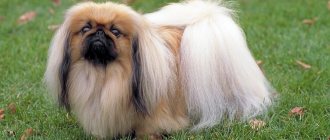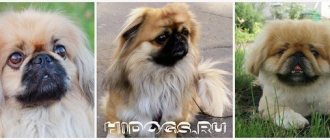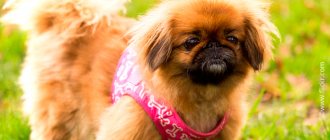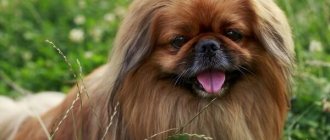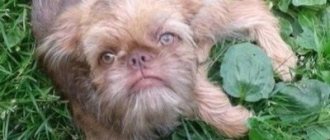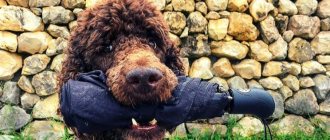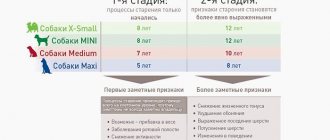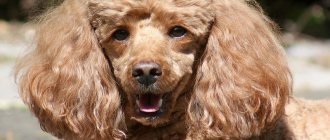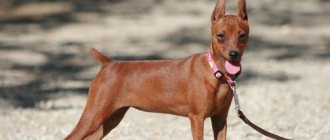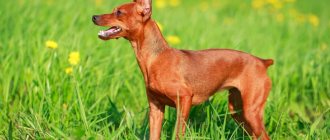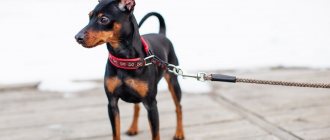History of the origin of the breed
Several years ago, American dog handlers became concerned about the origins of the Pekingese. They took DNA from the dogs, examined it and came to interesting conclusions. The animal has common roots with the wolf. The owners of the breed did not like the relationship; they liked the beautiful legend about the origin of the little pets much more.
Legend No. 1
Many, many years ago, a formidable and beautiful lion fell in love with a monkey. Agile and pretty, dressed in a white fur coat, she impressed the king of beasts. The situation in animal society was not conducive to the unification of loving hearts. The lion is the king of the fauna, the monkey is comparable to a simple peasant woman, what kind of union can we talk about?
Then the lion rejected his great height, crown and throne in order to unite with his beloved. From such an unusual union, a Pekingese dog was born, which inherited luxurious fur from its father, and facial expression and color from its mother.
Legend No. 2
The second story, concerning the origin of the Pekingese, is filled with sad events. The Royal Pekingese has been known for more than 2000 years, its homeland is China, and Empress Tsu-Khi had a hand in breeding representatives of the breed, who wrote its first standard in the 19th century. Until the middle of the declared century, nothing was known about the Pekingese dog breed outside of China. The year 1860 came, England and France defeated Beijing, the emperor with his family and servants were forced to flee. Only his elderly aunt remained in the summer palace, who considered it beneath her dignity to run away from enemies. Along with the woman there were five Pekingese dogs, two males and three females.
The further story has two branches. According to some sources, the invaders who broke into the palace found the aunt dead; she took her own life, but did not have time to kill the dogs. The second version tells that the elderly woman was unable to commit suicide. Her further fate is unknown, and the royal Pekingese ended up in the hands of marauders. The animals were taken to England, these dogs became the founders of the breed.
36 years later, in 1896, two more dogs were brought to the UK. According to one version, animals took an active part in the formation of the modern type of breed. However, comparing photos of the old-type Pekingese and the current one, this hypothesis raises serious doubts.
At the end of the 19th century, the Royal Pekingese ended up in the USA, where the dog was appreciated. Breeding work began, in which the Japanese Chin was involved. To this day, all breeders in the world focus on English Pekingese, trying to get a show animal.
Breed in Russia
According to official data, the Pekingese breed appeared in Russia in the 50s of the 20th century. However, there is a hypothesis that the miniature dog was popular among the highest nobility under Nicholas II. His daughter Anastasia was given an animal named Jemmy. According to unverified information, Jemmy was shot along with his owner.
Interesting fact! To this day, only rich people keep Pekingese in China. The tax on a representative of this breed is very high.
Character
The Pekingese is a loyal, balanced, dignified dog, sometimes capricious and wayward. It is easy to use and does not impose its communication on family members. If offered, I’m ready to play, and if not, I’ll calmly spend time alone.
The dog is jealous of his bowls, toys, and bed. He is the owner and will not allow strangers to invade his personal space. This character trait can cause difficulties - Pekingese aggression must be stopped from an early age.
Unlike most decorative dogs, the Pekingese does not bark in vain.
He greets guests calmly and is condescending with strangers. Treats other pets favorably, but demands respect. If necessary, he fearlessly rushes into battle, despite his miniature size.
In training, it requires a firm hand - if the owner is inconsistent in establishing rules of behavior and punishes without reason, the dog becomes irritable, stubborn, and vindictive.
Varieties and description of the Pekingese breed
Types of Pekingese are divided into:
- Pekingese;
- standard or royal Pekingese;
- The sleeve Pekingese stands out in particular.
The first category includes old-type dogs, which are very different from modern representatives of the breed. About 100 years ago, more graceful Pekingese were bred, taller than today, with a long body. Today, old-type dogs are extremely rare, they do not meet the standard, and participation in exhibitions and breeding is prohibited.
The smallest Pekingese is called the Sleeve. According to a beautiful legend, representatives of the Chinese imperial family carried tiny dogs in their sleeves. The sleeves of clothes were wide, the wind often blew in the palaces, and small dogs served as living protection from the cold.
Modern sleeve dogs are rarely born, because females do not take part in breeding. They are too small, natural birth ends in death, veterinary intervention can end the same way. It is enough to exceed the dose of sleeping pills in order to put the animal to sleep during a cesarean section, and the pet will never wake up.
Sleeve males are bred to standard females; the probability of giving birth to a tiny Pekingese is very low. These dogs cost incredible amounts of money and differ in size from the royal representative of the breed.
The weight of sleeve Pekingese does not exceed 3 kg , in all other respects they are the same as standard dogs.
Royal Pekingese standard
The description of the Royal Pekingese, according to the FCI standard from 2009, looks like this:
- General appearance: a small dog with an intelligent expression of the muzzle, stocky. A strong sense of self-esteem and superiority is expressed.
- Head: large, wide. The skull is voluminous, flat between the ears and wide.
- The muzzle is short, wide, and clearly visible.
- The eyes are round, medium in size, dark in color.
- The nose is short and wide, the nostrils are large and open. A light fold stretches from the cheekbones to the bridge of the nose, representing an inverted “V”.
- The lips are dense and should not hide a pronounced chin. The teeth and tongue are not visible behind the lips.
- The ears are heart-shaped, located at the level of the top line of the skull, reaching the bottom line of the muzzle, but not descending beyond it. Fit tightly to the head.
- The neck is thick and short.
- The body is short, the waist is clearly defined.
- The chest is wide, the ribs are well sprung.
- The front legs are wide and flat, sometimes turned slightly outward.
- The hind legs are strong and well developed.
- The tail is set high and is often carried over the back or side.
Size and weight
According to the breed standard, the ideal weight of the Royal Pekingese is 5.5 kg .
- The minimum weight for a male dog is 5.3 kg, the maximum is 6 kg.
- The minimum weight of a female is 4.8 kg, the maximum is 5.7 kg.
- The height of the male is 19-23 cm.
- Bitch height from 18 to 21 cm.
Color and coat type
The Pekingese coat description is as follows:
Long, straight. A collar is formed around the neck, which should not extend beyond the shoulder blades. The undercoat of dogs is dense and soft, the outer coat appears rough. There are feathers on the ears, hind legs and tail. The fur should not interfere with the movement of the animal; its excessive length is considered a defect.
The Imperial Pekingese comes in numerous colors. The most common are red and fawn representatives of the breed.
The main colors are presented in the list:
- Red is divided into several options: light red, golden, red. Having a dog of red color, for example, the owner will receive a pedigree for it, in the color column it is indicated “red”. You need to know that the color subtype is not specified in the pedigree, only red.
- Today, dogs with a gray color are becoming popular. They look great. Gray color can vary from fawn to dark silver.
- Pekingese dogs are very beautiful and have a milky color.
- There are representatives of the breed that are black and white.
- Paticolor is a fairly common occurrence among Pekingese. The dog is painted white and red.
- Black and tan color is very rare. Its carriers are short-haired Pekingese; such dogs are born extremely rarely in the kennel.
- The Black Pekingese is another rare representative of the breed. Often puppies are born with white markings on the forehead and paws, this is not a defect.
- If a buyer is offered a white Pekingese with blue eyes, he should run away from such a breeder. They want to sell an albino to a naive person, passing him off as a purebred dog. Albinos are considered a breeding match, a true white Pekingese has dark eyes, black eyeliner around them and a pigmented nose.
IMPORTANT! If a breeder heavily praises a small puppy, passing it off as a dwarf Pekingese, you should run away. The buyer is faced with a typical breeder, because breeders know that the name “dwarf” is not used in relation to the breed.
Reasons for dividing the breed
Probably, now many dog lovers will be surprised, because Pekingese actually differ in size. Let's look at breed standard No. 207 and study it carefully. There is not a single mention of “kings” or “dwarfs”. The standard specifies only the ideal weight of these animals - 5.4 kg (females) and 5 kg (males). In other words, an animal that meets all other requirements of the standard, but weighs 2 kg, is also recognized as a Pekingese.
The lack of strict instructions on the desired height and minimum weight of adult individuals was the reason for the stratification of the breed into:
- Royal (standard Pekingese). These animals have an ideal weight for the breed. If they meet the standard, they are allowed to breed. In some rather rare cases, when crossing two Royal Pekingese dogs, the puppies may be born dwarf.
- Sleeve, mini, dwarf, toy Pekingese, which weigh no more than 3.18 kg (in Canada and the USA - 2.72 kg, in England 3.17 kg). Mini bitches are not allowed to breed as they may give birth to standard puppies. As a result, this will lead to the death of the mother.
As for males, they actively mate with standard animals to produce “dwarfs”. This is always a more expensive litter. Mini Pekingese are not allowed for exhibitions, although in some countries - England, Canada, the USA - the first step towards their exhibition career has already been taken. Amateur shows began to be held here.
Dog lovers should know that the Royal Pekingese is no different from dwarf animals (except for size). The characteristics of the breed do not provide any differences in coat type and color.
Probably, now many dog lovers will be surprised, because Pekingese actually differ in size. Let's look at breed standard No. 207 and study it carefully. There is not a single mention of “kings” or “dwarfs”. The standard specifies only the ideal weight of these animals - 5.4 kg (females) and 5 kg (males). In other words, an animal that meets all other requirements of the standard, but weighs 2 kg, is also recognized as a Pekingese.
- Royal (standard Pekingese). These animals have an ideal weight for the breed. If they meet the standard, they are allowed to breed. In some rather rare cases, when crossing two Royal Pekingese dogs, the puppies may be born dwarf.
- Sleeve, mini, dwarf, toy Pekingese, which weigh no more than 3.18 kg (in Canada and the USA - 2.72 kg, in England 3.17 kg). Mini bitches are not allowed to breed as they may give birth to standard puppies. As a result, this will lead to the death of the mother.
READ Cat breeds: shorthair, longhair, hairless
As for males, they actively mate with standard animals to produce “dwarfs”. This is always a more expensive litter. Mini Pekingese are not allowed for exhibitions, although in some countries - England, Canada, the USA - the first step towards their exhibition career has already been taken. Amateur shows began to be held here.
Health and illness
When purchasing a representative of the breed, you should be prepared for regular visits to the veterinarian, because the dogs are quite painful. Those dreaming of a puppy are presented with a list of possible diseases:
- Cataracts, in which the lens of the eye changes. The changes lead to clouding of the eye or blindness.
- Distichiasis or abnormal eyelash growth.
- Turning of the eyelid outward.
- Turning of the eyelid inward.
- Dermatitis of the muzzle that occurs in its folds.
- Hemolytic anemia or destruction of red blood cells.
- Hypoplasia of the tooth. With this disease, there is no development of part of the second vertebra, which leads to its mobility.
- Hypothyroidism is an endocrine disease leading to the destruction of the thyroid gland.
- Disease of the intervertebral discs, they become prone to ruptures and displacements.
- Inguinal hernia.
- Keratitis, characterized by a lack of tears in one or both eyes.
- Atresia of the tear streams, in which they are too small or not formed at all.
- Displacement of the lens, characterized by its incorrect position.
- Microphthalmia. With this condition, one or both eyes are too small.
- Pannus is the growth of tissue above the cornea of the eyes.
- Inflammation of the cornea in which the pigmentation is abnormal is called pigmentary keratitis.
- Retinal atrophy.
- Skull too short.
- Ulcerative keratitis, accompanied by the formation of ulcers on the cornea.
- Thrombocytopenia, in which the platelet count in the blood is low. This leads to hemorrhages in the mucous membranes.
Lifespan
When thinking about purchasing a puppy, the potential owner wonders how long do Pekingese live? The lifespan of a representative of the breed varies from 12 to 15 years .
IMPORTANT! The imperial dog is quite sickly. Treatment is very expensive and not always effective.
Character and intelligence
When purchasing a charming baby, it is worth remembering its original purpose and luxurious life in the palaces of the Chinese imperial family. The little dogs had personal chefs, hairdressers and teachers; to date, representatives of the breed have retained their royal dignity.
The kids are smart, devoted to their owner and somewhat stubborn. To win the favor of a Pekingese, whose characteristics tell of his excessive sense of his own superiority, you will have to make an effort. Effort does not mean physical impact on the dog, but the owner’s immense patience. The Pekingese requires a respectful attitude towards its person; you can negotiate with the dog and explain it to it, but a representative of the breed will ignore orders.
Attitude towards children and others
A monkey dog is walking down the street, people are touched by the charming dog, children reach out to stroke it. The Pekingese looks kind and calm, but it categorically cannot tolerate a familiar attitude towards itself.
A little secret: a decent breeder will not sell his “graduate” to a family with children under six years of age. Kids try to express feelings towards the animal by lifting it by its front paws, sharply tugging on its fur, or trying to put a finger in its mouth. The puppy has not yet learned to resist; such treatment will make him physically and mentally disabled. An adult dog is patient with children, she is unlikely to bite a little bully, but being a nanny is beneath her dignity.
The dog is lenient towards strangers; if they try to pet the Pekingese and demonstrate their friendly attitude, he will accept the affection. At the same time, the dog will look truly royal; with his facial expression, the representative of the breed says “so be it, pet me.”
Prefers to be the only pet in the family and has a hard time getting along with burrowing dogs. The latter turn the Pekingese into a neurasthenic - hysterical.
IMPORTANT! The animal is not suitable for families with small children.
Dwarf Pekingese: description of the breed, character, maintenance, care
Small dog, expressive eyes, royal appearance. All this about the Dwarf Pekingese breed. These are lap dogs that have expressive eyes and luxurious fur. We will consider further the characteristics of the character and maintenance of dwarf Pekingese.
Origin story
The breed, as the name suggests, comes from Beijing. Dogs were mentioned in 2000 BC. e. According to legend, they protected the palace and the royal family from evil spirits. After the death of the owner, the dog was also subject to burial.
The Chinese emperor had 5 dogs that lived in the women's half of the palace. No one except the royal family had the right to keep a dwarf Pekingese; this was punishable by death.
The dogs had their own servants; if anything happened to the pet, the servants were executed.
The exact origin story is unknown. There are several versions, the most realistic is that the breed appeared through selective breeding. Pekingese were first brought to Europe in the 60s of the 19th century, thanks to the British who captured the Summer Palace. After this, the Royal Pekingese began to spread throughout the world.
Description of the breed
The height of an adult mini Pekingese is about 20 cm, weight is about 3 kg. The head is wide, large (disproportionate) in comparison with the body. The transition from the forehead to the nose is clearly defined. The muzzle is described as similar to that of a monkey. Ears are turned forward and hanging. The eyes are round, bulging, dark brown. The paws are powerful, the pads are flat. The hind ones are shorter than the front ones and are directed backwards.
Color may vary:
- black and red;
- pale yellow;
- golden;
- black;
- white.
Thanks to its fur and mane, the puppy resembles a lion.
Care and maintenance
baby is possible only in the apartment. Care must be careful. For wool, it is better to purchase a spray to make it easier to comb. You need to be especially careful when combing the ears, as they are easily damaged. The hair between the toes is trimmed, otherwise it will interfere with walking.
After feeding, the muzzle is thoroughly wiped, and after a walk, the paws and tummy are wiped. Bath the Sleeve Pekingese in warm water using a special shampoo for long-haired dogs once a year.
After bathing, dry with a hairdryer and comb thoroughly. You can use dry bathing with special products. Caring for the eyes of a dwarf pet has its own characteristics.
They are cleaned daily with a soft handkerchief, removing dust and dirt.
It is not recommended to wipe the eyes with a cotton swab, as they irritate the Pekingese's cornea.
Pekingese eyeballs can fall out, so the condition of the visual apparatus must be monitored. If purulent discharge appears, you should contact your veterinarian. In this case, antibiotic drugs are usually used.
Ears are cleaned with special products for dogs. They dissolve the sulfur mass. You can use 3% hydrogen peroxide. It is necessary to monitor the teeth: after each feeding, the animal’s mouth is inspected for stuck food.
Trim the claws from time to time, otherwise they will grow ingrown.
Training and education
Raising a pet must begin from the first day of its stay in a new home. They immediately explain to the child what is possible and what is not. From an early age, it is necessary to teach your puppy to go to the toilet in a certain place. Pekingese are difficult to train.
They are physically weaker than other breeds, so it is necessary to calculate their capabilities. Training should begin with the fu command. The fact is that the dwarf Pekingese loves to chew things, jump, bite, and bark loudly.
Therefore, as soon as the owner voices the command, the pet must stop its actions.
You shouldn’t raise your voice at your baby, otherwise he will get scared and won’t listen.
It is necessary to exercise your mini Pekingese at a clearly defined time (for example, after sleep). First they learn simple commands, then more complex ones. The puppy should be praised for its success. Since babies can be stubborn, you need to be persistent and patient.
How to choose a puppy
The Dwarf Pekingese is a rare breed. Puppies are born infrequently, so you may have to wait for the baby. When choosing, you need to study the documents, since you can buy a mestizo or mongrel dog. You should also look at photos of the parents or see them in person. You should not buy a puppy under 8 months of age, as you may mistakenly buy a regular Pekingese.
Pros and cons of the breed
Before you decide to buy a mini Pekingese, you need to familiarize yourself with the advantages and disadvantages of the breed:
| pros | Minuses |
| Brave and non-aggressive | Stubborn, jealous, touchy |
| Thanks to its small size, it is suitable for living even in a small apartment | Eye care should be especially thorough |
| Good health (mainly eye diseases), life expectancy over 10 years | Regular grooming is required |
| Excellent mini watchman | Not suitable for families with small children |
Having studied the characteristics, advantages and disadvantages of the breed, it is easier to make a choice.
Where to buy and price
It is better to buy puppies in a specialized place. Some of the popular nurseries are Palaceoutlaw and Savelina. The price for a puppy is 1,000-3,000 dollars.
Bitches need to be spayed. The fact is that dwarfism is not inherited. This size is obtained by chance. The Miniature Pekingese female cannot tolerate puppies and may die. Males are used for breeding.
The dwarf variety of Pekingese will become a special favorite, an indoor decorative dog. This is not only a cute creature, but also an excellent companion.
Source: https://dogs-fan.club/karlikovyy-pekines/
Training and education
A dog, regardless of its breed and size, must know basic commands. The imperial dog is no exception to the rule; you can train your baby at home.
It all starts with adopting a nickname. Keeping in mind the stubbornness of the small Pekingese dog, education and training is based on positive reinforcements. The dog has completed the task - it is rewarded with something tasty and praised.
Dog training
Problems with raising and training Pekingese are extremely rare. The owner is advised to be patient.
The easiest way is to use the services of a professional trainer. It is recommended to contact him within two months after birth. In this case, you will be able to achieve results quickly and secure them for life.
The Pekingese is an independent creature that does not tolerate being treated as a funny toy.
Pros and cons of the breed
According to the characteristics of the breed, the Pekingese has a tiny body, but the heart of a lion. In first place among his positive qualities is his courage.
- There are several types of Pekingese, as described above. All of them are fearless, capable of rushing into battle, protecting the owner from a two-legged enemy or a large dog. Owners say that their pets have long forgotten about their own size.
- The Pekingese, who once lived in the palaces of the Chinese emperor, remembers his roots. Our ancestors had an amazing sense of self-esteem, and today's dogs have preserved and increased it. This means that the baby will begin to behave as if he is the owner. The animal will not run after the owner, begging for attention and affection, but will favorably accept the manifestation of his feelings towards himself.
- When walking, he prefers the company of his owner; escapes are a rare occurrence among Pekingese.
Disadvantages of the breed:
- Predisposition to numerous diseases.
- Cold attitude towards children and pets.
- Fancy in care and maintenance.
- High cost of a show class puppy.
Character traits
Pekingese are proud dogs, accustomed to special treatment and the fact that the whole world revolves around them. This is exactly the kind of attitude they expect from their owners.
From the very first days of their appearance in the house, these dogs establish contact and a close emotional connection with their owner, which determines their ability to capture a person’s mood and sense changes in him.
Representatives of this breed are characterized by calm, measured behavior; although they are attached to their owner, they are not inclined to impose their company and tolerate loneliness without problems, since they are quite independent.
However, this does not mean that Pekingese do not need attention. On the contrary, if there is a lack of it, the pet’s behavior may change for the worse, and aggression is possible, especially towards the one who receives more attention from the owner.
Representatives of this breed are smart, so they quickly remember how they can or cannot behave, but natural stubbornness can seriously complicate the training process, so the owner will need maximum patience, endurance and perseverance.
Royal Pekingese are true imperial dogs. They are used to being idolized and treated with all honors and do not tolerate disdain. These dogs cannot stand noise and scandals, they need peace and tranquility, so they are ideal as a pet for elderly couples. They tolerate short-term loneliness well, but if the owner is not around for more than a few hours, they begin to feel sad and melancholy, which can lead to a complete refusal of water, food, and even their favorite treats.
Dog diet
Your pet needs a balanced and high-quality diet - natural food or dry food.
List of permitted products:
- Lean meat, boiled. Preferably veal or turkey, beef is too tough, chicken is an allergenic product.
- Occasionally they give rice and oatmeal; excessive consumption of carbohydrates will lead to weight problems.
- Vegetables, excluding potatoes and corn.
- Dairy products: low-fat cottage cheese and kefir, natural yogurt, homemade cheese are the favorite delicacies of the Pekingese breed, whose origins began with imperial dogs. They ate gourmet meals prepared by a personal chef. Current representatives of the breed have to be content with ordinary food.
- Once a week, a boiled quail egg is allowed.
- The menu must include a vitamin complex and fish oil.
Feeding natural food does not provide the animal with the vitamins that “drying” provides. Choose super-premium food for small breed dogs.
Care and maintenance
The animal does not tolerate heat well due to the structure of its muzzle. It is possible that breathing problems may occur, so the owner must provide the pet with a cool place where it can wait out the heat. Walks are carried out in the early morning or late evening, while the air temperature is comfortable for the dog.
The Pekingese has long hair, such a rich coat requires proper care.
Dog grooming
When getting a Pekingese, you should prepare for daily brushing of your pet. Particular attention is paid to the ears and groin area, where the hair often forms mats. Pets do not need a haircut; just trim the hair around the anus.
In order to avoid constant washing of the dog, in spring and autumn they walk with it in special clothes. A suit or overalls protects the lower part of the body from moisture and dirt; after a walk, the owner will only have to wash the pet’s paws.
As for bathing, it is carried out no more than once every two to three months. If the dog is very dirty, you cannot do without the procedure.
Ear and nail care
The ears of the imperial dog are examined daily; the auricle should be clean, pink in color, without the presence of inflammation or unpleasant odor. It is regularly wiped with a dry cotton swab.
Nails are trimmed once every three weeks with special nail clippers. You can perform the procedure yourself or contact a veterinary clinic for help.
Eye treatment and dental examination
The eyes are the most vulnerable part of the Pekingese's body. Owners need to protect their pet from eye injuries. The slightest bruise will cause the eyeballs to leak or dislocate.
If purulent discharge occurs, you should immediately contact a specialist. Any independent treatment of the visual organs will lead to tragic consequences.
The dog's teeth are brushed twice a week. If plaque, bleeding gums, redness or swelling are detected, immediately take your pet to a veterinarian. Another signal of impending dental disease is an unpleasant odor from the mouth.
How to choose a puppy
Those who want to buy puppies and have studied breed forums before purchasing one know what a Pekingese dog looks like. They buy babies only from specialized nurseries. Breeders who value their reputation will not sell a puppy younger than two months (before the first vaccination). When choosing a baby, pay attention to its appearance:
- The tummy is firm, but not bloated. His skin is pale pink.
- The nose is wide and open nostrils.
- The eyes are round in shape, there is no feeling that one is smaller than the other.
- The area around the anus is clean.
- The puppy looks cheerful, there is no lameness.
- The baby reaches out to the person, expressing a desire to get to know each other.
The cost of a baby depends on its level. Show-class puppies are more expensive than breed (brit) or pet. The latter are sold for castration or sterilization, which eliminates the possibility of puppies being born without documents.
The price of an exhibition specimen starts from 40,000 rubles , there is no upper limit. pet class dog will cost 10,000 – 15,000 rubles .
The Pekingese is a dog with a sense of self-esteem. Representatives of the breed are suitable for people who lead a measured lifestyle and have a certain income, because the dog’s illness implies expenses for its treatment.
Appearance of the breed
Pekingese dogs are very miniature and short in stature.
The average weight is 4-6 kg. They are classified as long-livers, so their life expectancy can reach 20 years. At the withers, the Imperial Pekingese reaches no more than 30 cm. It is also known that both ordinary and dwarf dogs can be born in one litter.
- Therefore, the opinion that dwarf Pekingese is a separate type of breed is erroneous. It’s just that the weight of such a dog will not exceed 3 kg.
The animals are slightly narrower in the lower back than in the back, and the shoulder blades are set obliquely. Although the back itself is flat. The Pekingese's tummy is tucked, and the withers are well defined and muscular.
The paws look quite massive relative to the body, with the front paws being larger than the hind paws. Long hair must grow between the toes.
The Pekingese's coat is elongated and slightly fluffy, although you can also find smooth-haired dogs of this breed.
The quality of the coat depends on a number of factors, including the feeding of the mother and puppies, as well as the litter in which the dogs were born.
The Pekingese's muzzles are wide and short, with a fold. The shape of the fold, according to dog breeders, does not matter.
The breed standards have strict requirements for the tail. Of particular importance is its length, position, shape. The tail should be positioned high, bend slightly to the side and fit snugly to the back.
The ears of representatives of this dog breed are small and heart-shaped. Although the coat on them is long and because of this it often seems that the dog’s ears are drooping.
Pekingese have large, beautiful eyes. They are slightly convex and have a brown color. But if the eyes are almost black or, conversely, light, then this is a deviation from the norm.
You definitely need to pay attention to the dog's jaw. Teeth should be straight and white. The upper and lower jaws are tightly adjacent to each other. Pekingese sometimes have an overbite.
- The color of the Pekingese is more than diverse. By the way, this is an exceptional dog breed that produces albino puppies. The most popular are red and fawn coat colors, but black and white dogs are no less common.
